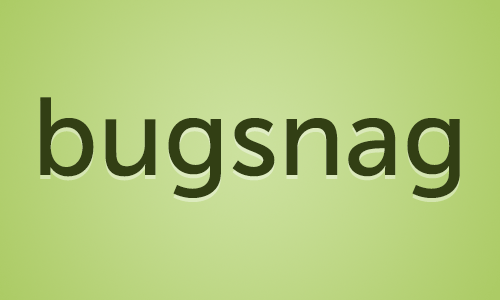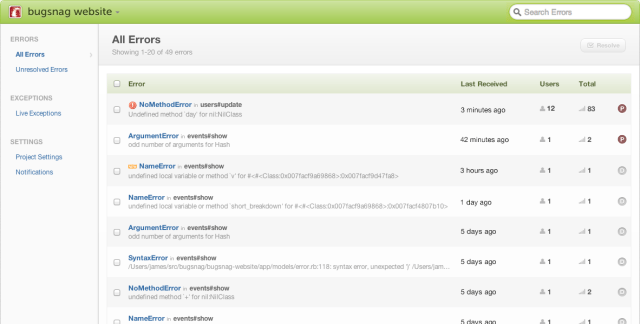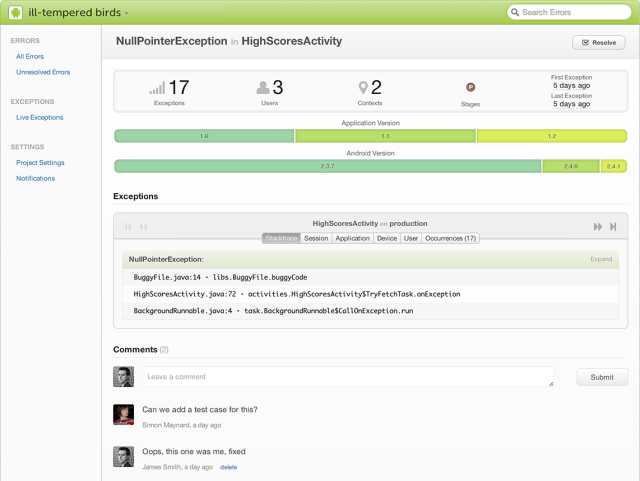Crash detection and reporting are tough but important problems to solve, as companies look to increase the stability and reliability of their online and mobile applications. One newer startup taking on this challenge, Bugsnag, has already found traction in this space, having signed up a number of notable customers, including LinkedIn, Svbtle, and Kiipt, among others. Today, the company is announcing $1.4 million in seed funding in a round led by Matrix Partners.
Others participating in the round include angels with cloud and SaaS experience, like Slicehost founder and TechStars Cloud director Jason Seats, and Huddle founder Andy McLoughlin.
Bugsnag itself was founded last summer by Simon Maynard and James Smith, both who left mobile gaming startup Heyzap where Smith was CTO, in order to create an affordable, full-stack monitoring service for businesses in need of collecting diagnostic information about their applications. The platform launched publicly in the beginning of 2013, following three months of beta testing, where it was then tracking on average 800,000 crashes per day thanks to customers like LinkedIn, Codeacademy, Treehouse, Customer.io, and DNSimple, to name a few. Today, it measures 5 million crashes per day and has detected over a billion since February.
To differentiate itself from other bug-reporting platforms, like Crittercism, Twitter-owned Crashlytics, or recent Splunk acquisition BugSense, which focus on mobile, or Airbrake and Exceptional, which cater to web developers, Bugsnag offers web, mobile and most recently, desktop support (OS X).
Explains Smith, Bugsnag is slightly different from other full platform services, like Splunk or New Relic. “They’re not bug detection, they’re normally logging or performance. And they’re not as actionable,” he says. “Their logs go into a log file, or their performance metrics goes into a dashboard. You need a team of dev-ops guys or sysadmins to go dig into that every day to grab meaning out of it.” Instead, Bugsnag wants to do the digging — and derive the meaning — for you.
In the Bugsnag dashboard, developers can track exceptions, filter errors with full-text search, search by error type, message or location, and configure notifications. These can be set to alert you upon the first occurrence of a bug, every time, or only when there’s an unusual spike in activity. And hooks into other programs are provided, as well, including favorite developer tools like Pivotal Tracker, GitHub Issues, Campfire, Hipchat, JIRA, Web Hooks, and of course, alerts can arrive via email, too.
The company also provides plugins for Rails, Django, PHP, Android, iOS, JavaScript, Node.js and Unity, and allows developers to build their own using its Notifier API.
The service has some secret sauce under the hood, as it can group exceptions together intelligently, so developers aren’t overburdened with duplicate alerts and emails. And even better, it can actually tell you how many users are currently affected by a particular exception, so you can prioritize which to fix first based on their real-world impacts.
At the time of its original launch, Bugsnag was working with a couple thousand customers, including several paying customers. Today the service offers a free hobbyist plan, as well as a 14-day free trial, followed by a $29/month plan for 25,000 exceptions, with additional exceptions 25 cents per each additional 1,000 tracked. Other plans, including those that let customers pay by monthly active users (in 100K chunks) are available, as well.
There are now 3,000-plus active customers, and while Bugsnag isn’t disclosing its revenue situation, Smith notes they were “Ramen profitable” ahead of the raise, and has been seeing 30 percent month-over-month revenue growth and about the same in terms of users, from beta launch to July.
With the new funding, which also see Matrix Partners’ Dana Stalder joining Bugsnag’s board, the immediate plans are to hire more engineers to help the company improve its mobile monitoring offerings. The now four-person team hopes to add eight or more new employees by year-end. They also just launched the above-mentioned desktop support, as well as improved iOS support, which includes debugging support for iOS 7 and the iPhone 5s’s new 64-bit processor — something that some competitors are now scrambling to do.
In the near term, the plan is to make the service and dashboard even easier to use by providing developers with actionable answers rather than just data, says Smith. Longer-term, Bugsnag wants to expand to other areas in need of actionable monitoring, including server monitoring and infrastructure.
“Right now we have the backend and mobile monitored…but there are a ton of problems that happen on infrastructure that affect the application,” says Smith. “The kind of engine we’re building behind the scenes looks at the trends and tries to tie everything all together. The more we improve our engine, the more parts of the stack we can apply it to.”


